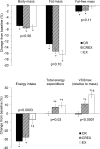Calorie Restriction and Matched Weight Loss From Exercise: Independent and Additive Effects on Glucoregulation and the Incretin System in Overweight Women and Men
- PMID: 25877812
- PMCID: PMC4477336
- DOI: 10.2337/dc14-2913
Calorie Restriction and Matched Weight Loss From Exercise: Independent and Additive Effects on Glucoregulation and the Incretin System in Overweight Women and Men
Abstract
Objective: It is not known whether calorie restriction (CR) has additive benefits to those from exercise (EX)-induced weight loss. We hypothesized that weight loss from CR and EX (CREX) improves insulin sensitivity more than matched weight loss induced by EX or CR alone and that the incretin system may be involved in adaptations to CR.
Research design and methods: Sedentary, overweight men and women (n = 52, 45-65 years of age) were randomized to undergo 6-8% weight loss by using CR, EX, or CREX. Glucose, insulin, C-peptide, insulin sensitivity, and incretin hormones (glucagon-like peptide 1 [GLP-1] and glucose-dependent insulinotropic polypeptide [GIP]) were measured during frequently sampled oral glucose tolerance tests (FSOGTTs). Incretin effects on insulin secretion were measured by comparing insulin secretion rates from the FSOGTTs to those from a glycemia-matched glucose infusion.
Results: Despite similar weight losses in all groups, insulin sensitivity index values increased twofold more in the CREX group (2.09 ± 0.35 μM/kg/pM × 100) than in the CR (0.89 ± 0.39 μM/kg/pM × 100) and EX (1.04 ± 0.39 μM/kg/pM × 100) groups. Postprandial GLP-1 concentrations decreased only in the CR group (P = 0.04); GIP concentrations decreased in all groups. Incretin effects on insulin secretion were unchanged.
Conclusions: CR and EX have additive beneficial effects on glucoregulation. Furthermore, the adaptations to CR may involve reductions in postprandial GLP-1 concentrations. These findings underscore the importance of promoting both CR and EX for optimal health. However, because data from participants who withdrew from the study and from those who did not adhere to the intervention were excluded, the results may be limited to individuals who are capable of adhering to a healthy lifestyle intervention.
Trial registration: ClinicalTrials.gov NCT00777621.
© 2015 by the American Diabetes Association. Readers may use this article as long as the work is properly cited, the use is educational and not for profit, and the work is not altered.
Figures

References
-
- Weiss EP, Racette SB, Villareal DT, et al. .; Washington University School of Medicine CALERIE Group . Improvements in glucose tolerance and insulin action induced by increasing energy expenditure or decreasing energy intake: a randomized controlled trial. Am J Clin Nutr 2006;84:1033–1042 - PMC - PubMed
-
- Tuomilehto J, Lindström J, Eriksson JG, et al. .; Finnish Diabetes Prevention Study Group . Prevention of type 2 diabetes mellitus by changes in lifestyle among subjects with impaired glucose tolerance. N Engl J Med 2001;344:1343–1350 - PubMed
-
- Gulve EA, Spina RJ. Effect of 7-10 days of cycle ergometer exercise on skeletal muscle GLUT-4 protein content. J Appl Physiol (1985) 1995;79:1562–1566 - PubMed
-
- O’Gorman DJ, Karlsson HK, McQuaid S, et al. . Exercise training increases insulin-stimulated glucose disposal and GLUT4 (SLC2A4) protein content in patients with type 2 diabetes. Diabetologia 2006;49:2983–2992 - PubMed
Publication types
MeSH terms
Substances
Associated data
Grants and funding
LinkOut - more resources
Full Text Sources
Other Literature Sources
Medical

